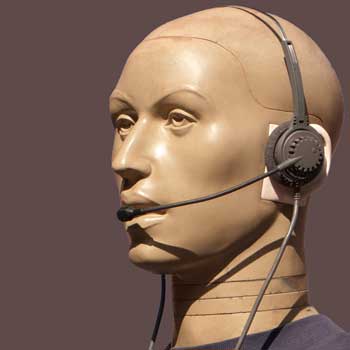Using headsets or earpieces, or on the phone …
Headsets, earphones, telephones and earpieces are used by many people in their work – telephonists, air traffic controllers, operators in fire, police or ambulance control rooms, pilots, typists, TV and radio staff, police officers and security guards. Probably the most numerous are people who work in ‘call centres’ or ‘contact centres’ selling products and services by telephone.
Measuring sound levels from headsets or earpieces is not difficult, but it does require specialist equipment and experience. We use a head and torso simulator known as ‘Kemar’. Kemar has the proportions of a median adult human, but has microphones in place of eardrums. Headphones or earphones fit Kemar just as they would a real person, and the sound levels at the eardrum microphones are typical of the sound levels which would be present at the eardrums of a median human adult under the same conditions. Because the ear canal amplifies sound at some frequencies we have to correct for this when assessing noise exposures.
We have used Kemar to measure noise from headsets in a wide range of situations. So where have we found noise problems?
We have usually found that noise exposures from headsets are below the Upper Exposure Action Value in the call centres and control rooms we have visited, even if operators choose to turn their volume controls up full. We have, however, found exceptions where exposures were high, and for this reason, we advise that sound levels be measured as a precaution. Acoustical treatments of rooms and furnishings can reduce background babble of busy colleagues, allowing operators to reduce their headset volume and hear more clearly. Binaural headsets, covering both ears rather than one, will also help reduce distracting background noise in the worst cases.


